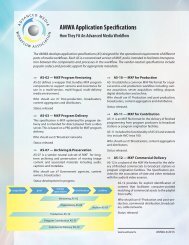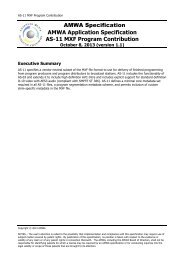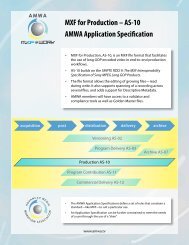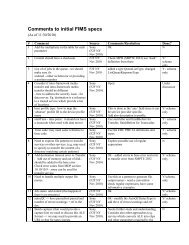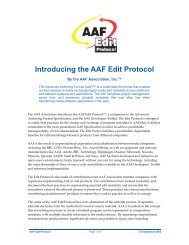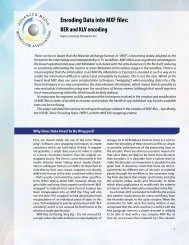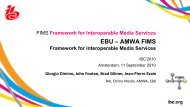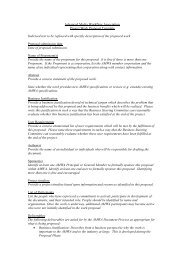Create successful ePaper yourself
Turn your PDF publications into a flip-book with our unique Google optimized e-Paper software.
<strong>FIMS</strong> <strong>Media</strong> <strong>SOA</strong> <strong>Framework</strong> Phase1 (Preliminary)9.5.3 Message-level SecurityMessage-level security entails encrypting or otherwise securing the messages that pass between services. WebServices, the most widely used technology for implementing <strong>SOA</strong> within an enterprise, is an XML‐basedcommunication protocol for exchanging messages between loosely coupled systems. Web Services provides anexcellent toolset to accomplish message‐based security, with technologies like XML encryption and signature. Inaddition, the most well‐accepted technique for achieving message‐based security in a Web services based <strong>SOA</strong>is to use a standard known as WS‐Security. WS‐Security goes hand‐in‐hand with standardized technologies like<strong>SOA</strong>P to secure messages and endpoints. It provides end‐to‐end security, which means that a message issecure even if it passes through a number of routing steps in between its source and destination.9.5.3.1 Security as a ServiceFigure xxx - NIST <strong>SOA</strong> Message Based Security PatternA security service can offer applications the ability to authenticate, authorize, encrypt/decrypt messages, signmessages/verify signatures, and log messages. It may also scrub messages to protect applications againstknown and unknown vulnerabilities. Applications might still need to know a little bit about security—forexample, they may need to know how to invoke a security service and use the information provided by thesecurity service in return—but the meat of the security logic can be executed by a central security service.The idea of a security service is in some ways similar to the idea of an application service, and in some waysdifferent. Like an application service, a security service should be usable by any application; technologydifferences should not be a barrier. Unlike an application service, a security service is infrastructural and maycome into play even if it is not explicitly invoked. For example the security service may be implemented as partof the ESB or by application-aware network devices.9.5.3.2 Policy-driven SecurityThe idea behind policy-driven security is simple. Security requirements and mechanisms must not be hard-wiredinto applications. Instead, security requirements of an enterprise should be declared separately as a "securitypolicy."Private committee documentWorking Draft for review by <strong>FIMS</strong> Rev v1, Nov-16-2010 Page 87 of 89



